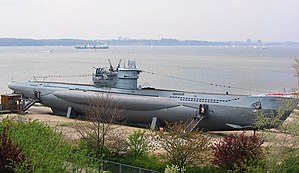
Back Tipe VII duikboot Afrikaans غواصة الفئة السابعة Arabic Падводныя лодкі тыпу VII Byelorussian Подводница от тип VII Bulgarian U-Boot tipus VII Catalan Typ VII Czech U-Boot-Klasse VII German Tipo VII Spanish او-بوت نوع ۷ Persian Tyyppi VII Finnish
This article may be in need of reorganization to comply with Wikipedia's layout guidelines. (September 2014) |
 U-995 Type VIIC/41 at the Laboe Naval Memorial near Kiel
| |
| Class overview | |
|---|---|
| Name | Type VII |
| Builders | |
| Operators | |
| Preceded by | Type II |
| Succeeded by | |
| Cost | 4,189,000 ℛ︁ℳ︁[1][2] |
| In commission | 1936 – 1970 (G-7) |
| Completed | 704[3] |
| Preserved | 1 (U-995) |
| General characteristics (Type VIIC) | |
| Displacement | |
| Length | |
| Beam |
|
| Height | 9.60 m (31 ft 6 in)[4] |
| Draft | 4.74 m (15 ft 7 in)[4] |
| Propulsion | 2 × supercharged 6-cylinder 4-stroke diesel engines totalling 2,800–3,200 PS (2,100–2,400 kW; 2,800–3,200 shp). Max rpm: 470–490[4] |
| Speed | |
| Range | |
| Test depth | |
| Complement | 44–52 officers & ratings[4] |
| Armament |
|
Type VII U-boats were the most common type of German World War II U-boat. 703 boats were built by the end of the war. The lone surviving example, U-995, is on display at the Laboe Naval Memorial located in Laboe, Schleswig-Holstein, Germany.
At the start of the Second World War the Type VII class was together with the British U, S and T class and Dutch O 21 class one of the most advanced submarine classes in service.[7]
- ^ Gröner, Erich (1990). German Warships 1815–1945. Annapolis: Naval Institute Press. p. 77. ISBN 0-87021-790-9.
- ^ Poirier, Michel Thomas, Commander, USN (20 October 1999). "Results of the German and American Submarine Campaigns of World War II". Archived from the original on 9 April 2008.
{{cite web}}: CS1 maint: multiple names: authors list (link) The cost of a Type VII is estimated at US$2.25 million (equivalent to $30 million in 2023). - ^ Cite error: The named reference
Westwood9was invoked but never defined (see the help page). - ^ a b c d e f g h i j k l m n o p Helgason, Guðmundur. "Type VIIC". U-Boat War in World War II. Uboat.net. Retrieved 10 February 2010.
- ^ Möller, Eberhard; Brack, Werner (2004). The Encyclopedia of U-Boats. London: Chatham. pp. 69–73. ISBN 1-85367-623-3.
- ^ Campbell, John (1985). Naval Weapons of World War Two. Annapolis: Naval Institute Press. p. 251. ISBN 0-87021-459-4.
- ^ van den Pol (1989), p. 352.
Cite error: There are <ref group=Note> tags on this page, but the references will not show without a {{reflist|group=Note}} template (see the help page).